LOCH SHIEL
A southwestward view of the lake from its northern end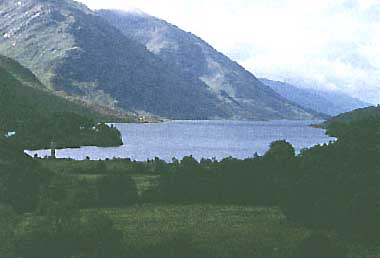 Photo: A. Kurata
Photo: A. Kurata
A. LOCATION
- Scotland, UK.
- 56:51N, 5:30W; 4.5 m above sea level.
B. DESCRIPTION
- Of glacial origin, Loch Shiel is the fourth largest
lake by length in Scotland and this is one whose water regime is among
the least affected by man. The lake has a total length of 28.0 km - only
exceeded by Lochs Awe, Ness and Lomond. Like Loch Awe, it is very narrow
with a mean breadth which is only 2.5% of its total length. The main upper
portion of the lake runs in a northeast/southwest direction, but about
8 km from the outflow the axis bends and the lower portion bends almost
due west. The surface area of the lake is 19.6 km2: it has a mean depth
of 40.5 m and a maximum one of 128.0 m. It contains a total volume of 892,500,000
m3.
Like Loch Lomond, the northern end of Loch Shiel is much deeper than the southern end. The basin is essentially a single one, but there are a number of minor depressions here and there, two of them deeper than 120 m.
Since the construction of the River Leven Barrage in Loch Lomond, only Loch Shiel has a natural outlet. Loch Awe is regulated by a barrage: Loch Ness is affected by the works associated with the Caledonian Canal and the short outlet channel from Loch Morar is influenced by a small hydro-electric scheme.
Loch Shiel has very similar catchments to Loch Morar in many respects; moderate altitude, but steep slopes, very little arable ground and base-poor geology. The lake, therefore, is likely to be very nutrient poor (1, 2, 4, 10).
C. PHYSICAL DIMENSIONS (1, 2)
| Surface area [km2] | 20 |
| Volume [km3] | 0.9 |
| Maximum depth [m] | 128.0 |
| Mean depth [m] | 40.5 |
| Water level | Unregulated |
| Normal range of annual water level fluctuation [m] | 2.0 |
| Length of shoreline [km] | 77.6 |
| Residence time [yr] | 1.4 |
| Catchment area [km2] | 234 |
D. PHYSIOGRAPHIC FEATURES
D1 GEOGRAPHICAL (2)-
Bathymetric map:
Fig. EUR-26-01.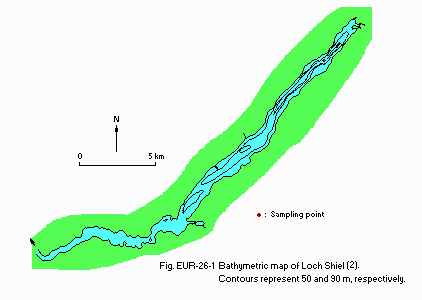
- Names of main islands: The area of island is 0.11 km2.
- Number of outflowing rivers and channels (name): 1 (R. Shiel).
- Climatic data at Achnashellach (3)*
| Mean temp. [deg C] | ||||||||||||
| Jan | Feb | Mar | Apr | May | Jun | Jul | Aug | Sep | Oct | Nov | Dec | Ann. |
|---|---|---|---|---|---|---|---|---|---|---|---|---|
| 2.8 | 3.2 | 5.2 | 6.9 | 10.1 | 12.4 | 13.8 | 13.6 | 11.6 | 8.7 | 5.7 | 4.1 | 8.2 |
| Precipitation [mm] | ||||||||||||
| 232 | 177 | 127 | 156 | 93 | 114 | 148 | 150 | 189 | 234 | 196 | 242 | 2,058 |
| * 13-year mean. | ||||||||||||
- Number of hours of bright sunshine: 1,374 hr yr-1.
- Water temperature: Fig. EUR-26-02.
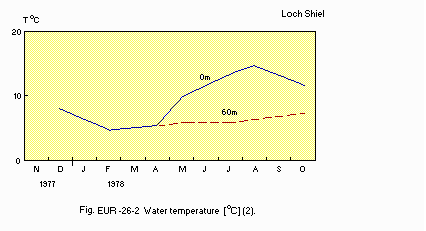
Water temperature [deg C](2).
- Freezing period: Occasionally (2).
- Mixing type: Monomictic (2).
E. LAKE WATER QUALITY
E1 TRANSPARENCY [m](6) November 1977 and Octber 1978: 5.1-8.0.E2 pH (4)
| 1977 | ||||||||||||
| Depth [m] | Jan | Feb | Mar | Apr | May | Jun | Jul | Aug | Sep | Oct | Nov | Dec |
|---|---|---|---|---|---|---|---|---|---|---|---|---|
| 0-10 | - | - | - | - | - | - | - | - | - | - | 6.2 | 6.3 |
| 1978 | ||||||||||||
| 0-10 | - | 6.2 | - | 6.2 | 6.1 | - | - | 6.1 | - | 6.2 | - | - |
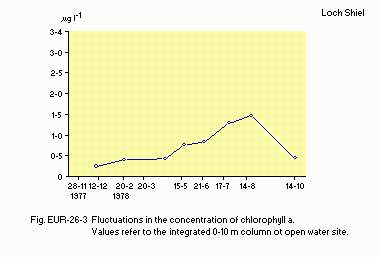
Fluctuations in the concentration of chlorophyll a. Values refer to the integrated 0-10 m column at open water site (5).
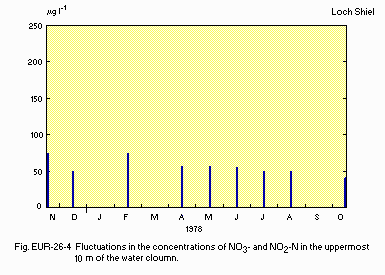
Fluctuations in the concentrations of NO3- and NO2-N in the uppermost 10 m of the water column (5).
- PO4-P value [micro g l-1]
November 1977-October 1978: <10.
F. BIOLOGICAL FEATURES
F1 FLORA- Submerged macrophytes (6)
- Phytoplankton (5)
Littorella uniflora, Lobelia dortmanna, Isoetes lacustris.
Rhizosolenia longiseta, R. eriensis, Tabellaria fenestrata, T. fenestrata var. asterionelloides, T. flocculosa, Cryptomonas erosa, C. ovata, Rhodomonas minuta.
- Zooplankton (7)
- Benthos (8)
- Fish (9)
Bosmina coregoni, Polyphemus pediculus, Bythotrephes longimanus, Leptodora kindti, Diaptomus gracilis, Cyclops abyssorum, Diaphanosoma brachyurum, Holope:dium gibberum, Diaptomus laciniatus.
Stylaria lacustris, Lumbriculus variegatus, Ecdyonurus dispar, Leuctra hippopus, L. fusca, Chloroperla torrentium, Lepidostoma hirtum.
Salmo salar, S. trutta, Anguilla anguilla, Gasterosteus aculeatus aculeatus, Platichthys flesus.
- Zooplankton: Fig. EUR-26-05.
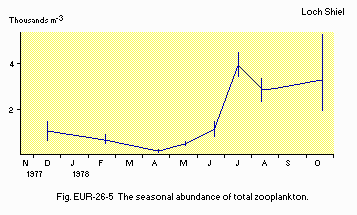
The seasonal abundance of total zooplankton [1,000 individuals m-3].
G. SOCIO-ECONOMIC CONDITIONS (1)
G1 LAND USE IN THE CATCHMENT AREA| Area[km2] | [%] | |
|---|---|---|
| - Natural landscape | ||
| Woody vegetation | 36.9 | 15.8 |
| Rough | 186.0 | 79.5 |
| - Agricultural land | 3.3 | 1.4 |
| - Residential area | 1.3 | 0.6 |
| - Others | 6.4 | 2.7 |
| - Total | 233.9 | 100 |
| Population | Population density [km-2] | Major cities (population) | |
|---|---|---|---|
| Total | 354 | 1.5 | None |
H. LAKE UTILIZATION (3, 10)
H1 LAKE UTILIZATION- Source of water, recreation (sight-seeing, swimming, sport-fishing).
I. DETERIORATION OF LAKE ENVIRONMENTS AND HAZARDS (4)
I1 ENHANCED SILTATION- Extent of damage: None.
- Present status: Not detected.
- Nuisance caused by eutrophication: None.
- Extent of damage: None.
J. WASTEWATER TREATMENTS (1)
J1 GENERATION OF POLLUTANTS IN THE CATCHMENT AREA- b) No sources of significant pollution.
- Municipal wastewater treatment systems: None.
- Industrial wastewater treatment systems
No.of industrial wastewater treatment systems: None.
N. SOURCES OF DATA
- Maitland, P. S. (1981) Introduction and catchment analysis. The Ecology of Scotland's Largest Lochs, Lomond, Awe, Ness, Morar and Shiel (ed. Maitland, P. S.), pp. 1-27. Dr. W. Junk Publishers, The Hague.
- Smith, I. R., Lyle, A. A. & Rosie, A. J. (1981) Comparative physical limnology. Ibid., pp. 29-65.
- Muller, M. J. (1982) Selected Climatic Data for a Global Set of Standard Stations for Vegetation Science. 306 pp. Dr. W. Junk Publishers, The Hague.
- Bailley-Watts, A. E. & Duncan, P. (1981) Chemical characterisation: a one-year comparative study. The Ecology of Scotland's Largest Lochs, Lomond, Awe, Ness, Morar and Shiel (see above), pp. 67-89.
- Ibid. (1981) The phytoplankton. Ibid., pp. 91-118.
- Ibid. (1981) A review of macrophyte studies. Ibid., pp. 119-134.
- Maitland, P. S., Smith, B. D. & Dennis, G. M. (1981) The crustacean zooplankton. Ibid., pp. 135-154.
- Smith, B. D., Maitland, P. S., Young, M. R. & Carr, M. J. (1981) The littoral zoobenthos. Ibid., pp. 155-203.
- Maitland, P. S., Smith, B. D. & Adair, S. M. (1981) The fish and fisheries. Ibid., pp. 223-251.
- The editor's observation.


